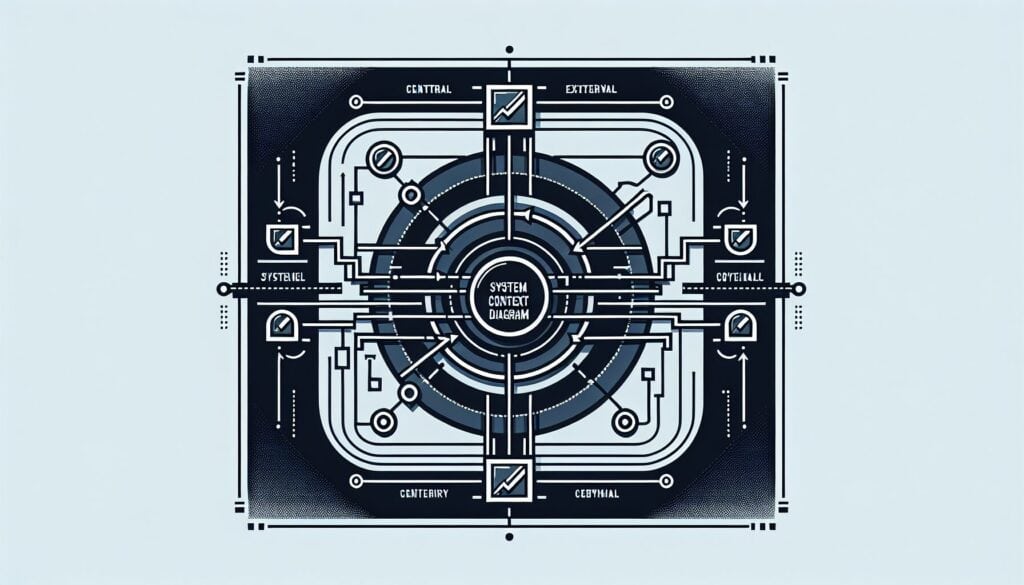Définir la frontière entre un système et son environnement, en indiquant les entités qui interagissent avec lui.
- Méthodologies : Ingénierie, Qualité
Diagramme du contexte du système

Diagramme du contexte du système
- Méthodologie Agile, Cartographie des processus, Gestion de projet, Gestion de la qualité, Conception du système, Expérience utilisateur (UX), Interface utilisateur (UI), User-Centered Design
Objectif :
Comment il est utilisé :
- Un diagramme de haut niveau qui montre le système comme un processus unique avec ses entrées et ses sorties de/vers des entités externes (par exemple, des utilisateurs, d'autres systèmes). Il définit la portée de ce qui doit être inclus dans le système.
Avantages
- Simple et facile à comprendre, même pour les parties prenantes non techniques ; définit clairement la portée et les limites du système ; aide à identifier toutes les interfaces externes et les parties prenantes.
Inconvénients
- Fournit une vue de très haut niveau et manque de détails sur le fonctionnement interne du système ; peut être trop simpliste pour des systèmes complexes ; peut ne pas saisir toutes les nuances des interactions du système.
Catégories :
- Clients et marketing, Ingénierie, Conception de Produits, Gestion de projet
Idéal pour :
- Établir la portée d'un système et identifier ses interactions et interfaces externes dès le début d'un projet.
System Context Diagrams are widely utilized in various sectors including software development, engineering, and product management as a means to clarify the interactions between a system and its environment. They prove particularly advantageous during the early phases of a project when requirements are being gathered, allowing teams comprising project managers, system architects, and stakeholders to visually encapsulate the system’s exterior elements, including end-users, other systems, and data sources. Industries such as telecommunications, manufacturing, and healthcare frequently adopt this methodology to ensure that all stakeholders comprehend the designed system’s boundaries and responsibilities. For instance, in healthcare IT projects, a System Context Diagram can depict how a patient management system interacts with external databases and medical devices, thus facilitating a shared understanding among clinical staff and IT professionals. Participants in the process typically include interdisciplinary team members—such as business analysts who articulate business needs, engineers who provide technical feasibility assessments, and compliance officers who must ensure regulatory guidelines are met. This diagrammatic approach not only simplifies communication with non-technical stakeholders but also lays a solid foundation for further methodologies like Functional Decomposition and Use Case Analysis, ensuring that the project’s direction remains aligned with stakeholder expectations and requirements as it evolves through subsequent phases.
Principales étapes de cette méthodologie
- Identify the system to be modeled.
- Define external entities that interact with the system.
- Determine the inputs and outputs for the system.
- Draw the system as a single process in the diagram.
- Connect external entities to their corresponding inputs and outputs.
- Review the diagram for clarity and completeness.
Conseils de pro
- Involve stakeholders early to validate identified inputs and outputs, ensuring all relevant perspectives are captured.
- Utilize iterative reviews of the diagram as the project evolves to adapt to changing requirements and maintain clarity.
- Document assumptions made during diagram creation to provide context for future project phases and decision-making processes.
Lire et comparer plusieurs méthodologies, nous recommandons le
> Référentiel méthodologique étendu <
ainsi que plus de 400 autres méthodologies.
Vos commentaires sur cette méthodologie ou des informations supplémentaires sont les bienvenus sur le site web de la Commission européenne. section des commentaires ci-dessous ↓ , ainsi que toute idée ou lien en rapport avec l'ingénierie.
Contexte historique
1980
1980
1986
1987
1990
1990
1990
1980
1980
1986
1986
1987-03
1990
1990
1992
(si la date est inconnue ou n'est pas pertinente, par exemple "mécanique des fluides", une estimation arrondie de son émergence notable est fournie)















Articles Similaires
Simulation de Monte Carlo
Tests basés sur des modèles
Contrôle des modèles
Recherche sur les méthodes mixtes
À l'épreuve des erreurs (Poka-Yoke)
Test du profil de la mission